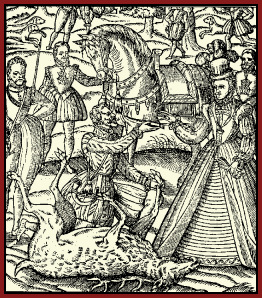The Hunt is Up
 Hunting is aristocratic privilege, sport, exercise, social occasion, and a means of putting
fresh meat on the table. The Queen is very fond of hunting, as are we all, at whatever early hour and in all weathers.
Hunting is aristocratic privilege, sport, exercise, social occasion, and a means of putting
fresh meat on the table. The Queen is very fond of hunting, as are we all, at whatever early hour and in all weathers.
All men and many women of the upper classes hunt unless prevented by age or infirmity. Very few people are squeamish about hunting, and none but the youngest child is sentimental about the fate of the prey.
The prey
The most dangerous prey is the wild boar, which is hunted only by men, on foot, with dogs and spears.The most common prey is deer, hunted on horseback and foot.
Venery (from Latin) refers to hunting, and venison is any game meat, but usually means specifically the meat of the deer. The words for collections of animals, such as a herd of deer or a pride of lions, are the terms of venery.
The red deer of medieval legend is now becoming rare even in the remotest regions. The male is a hart or stag, and the female is a hind. A yearling is a calf.
The fallow deer is the common deer, and is easiest to hunt. The male is a buck and the female is a doe.
The roe deer is a smaller deer, and is very rare except in old songs.
June is calving season. The two weeks either side of midsummer are known as fence month. To let the deer drop their calves undisturbed, the foresters put up fences at key access points to the forest, and charge a toll to any vehicles passing through.
The chase
A forest is not defined as wild, impenetrable woodland, but rather royal property which has been managed by officials called foresters for hundreds of years. Their job is to protect the "vert and venison"—the deer and the plants they rely on for food and cover—for the benefit of the Crown.In legal terms, even open, unwooded land can be a forest. In the time of King John, all of Essex including towns, villages, and farms was forest.
When the forest is a hunting preserve, it is a chase.
"A forest must always have beasts of venery abiding in it, otherwise it is no forest: and if there be no beasts of forest, nor beasts of chase in the same, then may men fell their woods that they have within the forest and destroy their covers"A park is a gentleman's private deer reserve. Most great estates have their own attached deer park for the hunting pleasure of the lord and his guests, and to provide fresh meat year-round.—John Manwood, Treatise on the Lawe of the Forests (1598)
Sources
Seeing the Forests for the Trees
Danziger: 1215, The Year of Magna Carta
Pollard: Imagining Robin Hood,
Whitlock: Historic Forests of England,
![]() A Cry of Hounds
A Cry of Hounds
![]() Now Merrily to Horse
Now Merrily to Horse
![]() Filling the Time
Filling the Time
![]() More Things To Do
More Things To Do
![]() Still More Things To Do
Still More Things To Do





13 March 2010 mps
